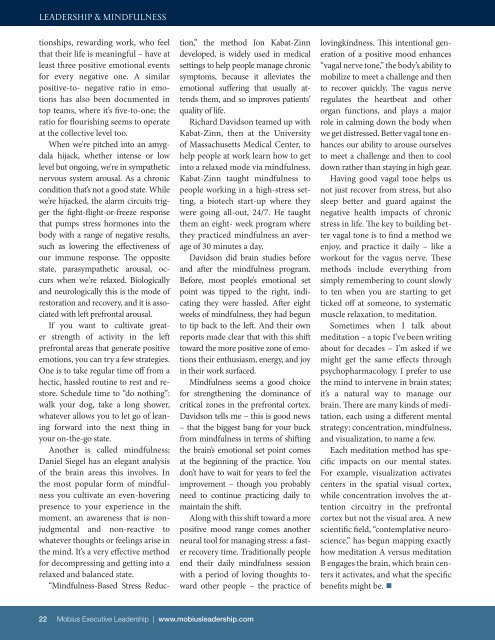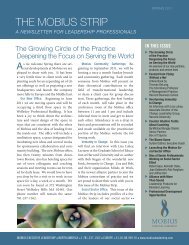Leadership & Mindfulness - Mobius Executive Leadership
Leadership & Mindfulness - Mobius Executive Leadership
Leadership & Mindfulness - Mobius Executive Leadership
Create successful ePaper yourself
Turn your PDF publications into a flip-book with our unique Google optimized e-Paper software.
LEADERSHIP & <strong>Mindfulness</strong>tionships, rewarding work, who feelthat their life is meaningful – have atleast three positive emotional eventsfor every negative one. A similarpositive-to- negative ratio in emotionshas also been documented intop teams, where it’s five-to-one; theratio for flourishing seems to operateat the collective level too.When we're pitched into an amygdalahijack, whether intense or lowlevel but ongoing, we're in sympatheticnervous system arousal. As a chroniccondition that’s not a good state. Whilewe’re hijacked, the alarm circuits triggerthe fight-flight-or-freeze responsethat pumps stress hormones into thebody with a range of negative results,such as lowering the effectiveness ofour immune response. The oppositestate, parasympathetic arousal, occurswhen we're relaxed. Biologicallyand neurologically this is the mode ofrestoration and recovery, and it is associatedwith left prefrontal arousal.If you want to cultivate greaterstrength of activity in the leftprefrontal areas that generate positiveemotions, you can try a few strategies.One is to take regular time off from ahectic, hassled routine to rest and restore.Schedule time to “do nothing”:walk your dog, take a long shower,whatever allows you to let go of leaningforward into the next thing inyour on-the-go state.Another is called mindfulness;Daniel Siegel has an elegant analysisof the brain areas this involves. Inthe most popular form of mindfulnessyou cultivate an even-hoveringpresence to your experience in themoment, an awareness that is nonjudgmentaland non-reactive towhatever thoughts or feelings arise inthe mind. It’s a very effective methodfor decompressing and getting into arelaxed and balanced state.“<strong>Mindfulness</strong>-Based Stress Reduction,”the method Jon Kabat-Zinndeveloped, is widely used in medicalsettings to help people manage chronicsymptoms, because it alleviates theemotional suffering that usually attendsthem, and so improves patients’quality of life.Richard Davidson teamed up withKabat-Zinn, then at the Universityof Massachusetts Medical Center, tohelp people at work learn how to getinto a relaxed mode via mindfulness.Kabat-Zinn taught mindfulness topeople working in a high-stress setting,a biotech start-up where theywere going all-out, 24/7. He taughtthem an eight- week program wherethey practiced mindfulness an averageof 30 minutes a day.Davidson did brain studies beforeand after the mindfulness program.Before, most people’s emotional setpoint was tipped to the right, indicatingthey were hassled. After eightweeks of mindfulness, they had begunto tip back to the left. And their ownreports made clear that with this shifttoward the more positive zone of emotionstheir enthusiasm, energy, and joyin their work surfaced.<strong>Mindfulness</strong> seems a good choicefor strengthening the dominance ofcritical zones in the prefrontal cortex.Davidson tells me – this is good news– that the biggest bang for your buckfrom mindfulness in terms of shiftingthe brain’s emotional set point comesat the beginning of the practice. Youdon’t have to wait for years to feel theimprovement – though you probablyneed to continue practicing daily tomaintain the shift.Along with this shift toward a morepositive mood range comes anotherneural tool for managing stress: a fasterrecovery time. Traditionally peopleend their daily mindfulness sessionwith a period of loving thoughts towardother people – the practice oflovingkindness. This intentional generationof a positive mood enhances“vagal nerve tone,” the body’s ability tomobilize to meet a challenge and thento recover quickly. The vagus nerveregulates the heartbeat and otherorgan functions, and plays a majorrole in calming down the body whenwe get distressed. Better vagal tone enhancesour ability to arouse ourselvesto meet a challenge and then to cooldown rather than staying in high gear.Having good vagal tone helps usnot just recover from stress, but alsosleep better and guard against thenegative health impacts of chronicstress in life. The key to building bettervagal tone is to find a method weenjoy, and practice it daily – like aworkout for the vagus nerve. Thesemethods include everything fromsimply remembering to count slowlyto ten when you are starting to getticked off at someone, to systematicmuscle relaxation, to meditation.Sometimes when I talk aboutmeditation – a topic I’ve been writingabout for decades – I’m asked if wemight get the same effects throughpsychopharmacology. I prefer to usethe mind to intervene in brain states;it’s a natural way to manage ourbrain. There are many kinds of meditation,each using a different mentalstrategy: concentration, mindfulness,and visualization, to name a few.Each meditation method has specificimpacts on our mental states.For example, visualization activatescenters in the spatial visual cortex,while concentration involves the attentioncircuitry in the prefrontalcortex but not the visual area. A newscientific field, “contemplative neuroscience,”has begun mapping exactlyhow meditation A versus meditationB engages the brain, which brain centersit activates, and what the specificbenefits might be. ■22 <strong>Mobius</strong> <strong>Executive</strong> <strong>Leadership</strong> | www.mobiusleadership.com



